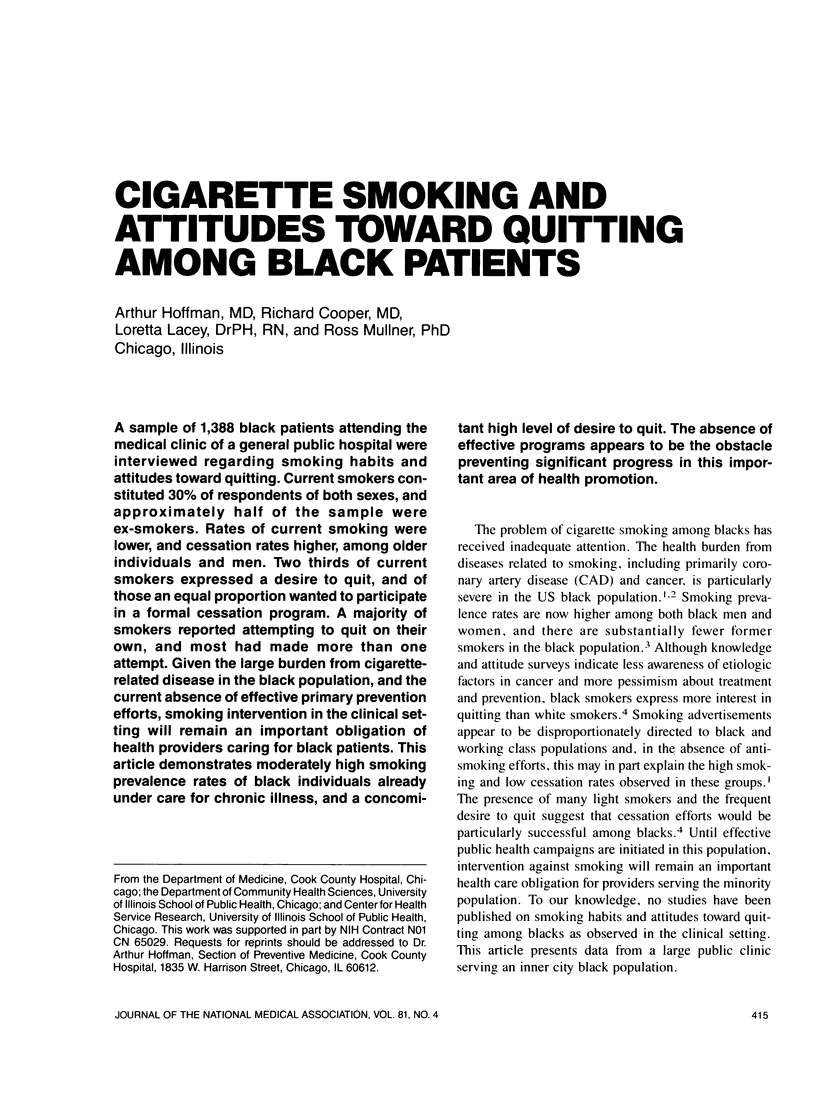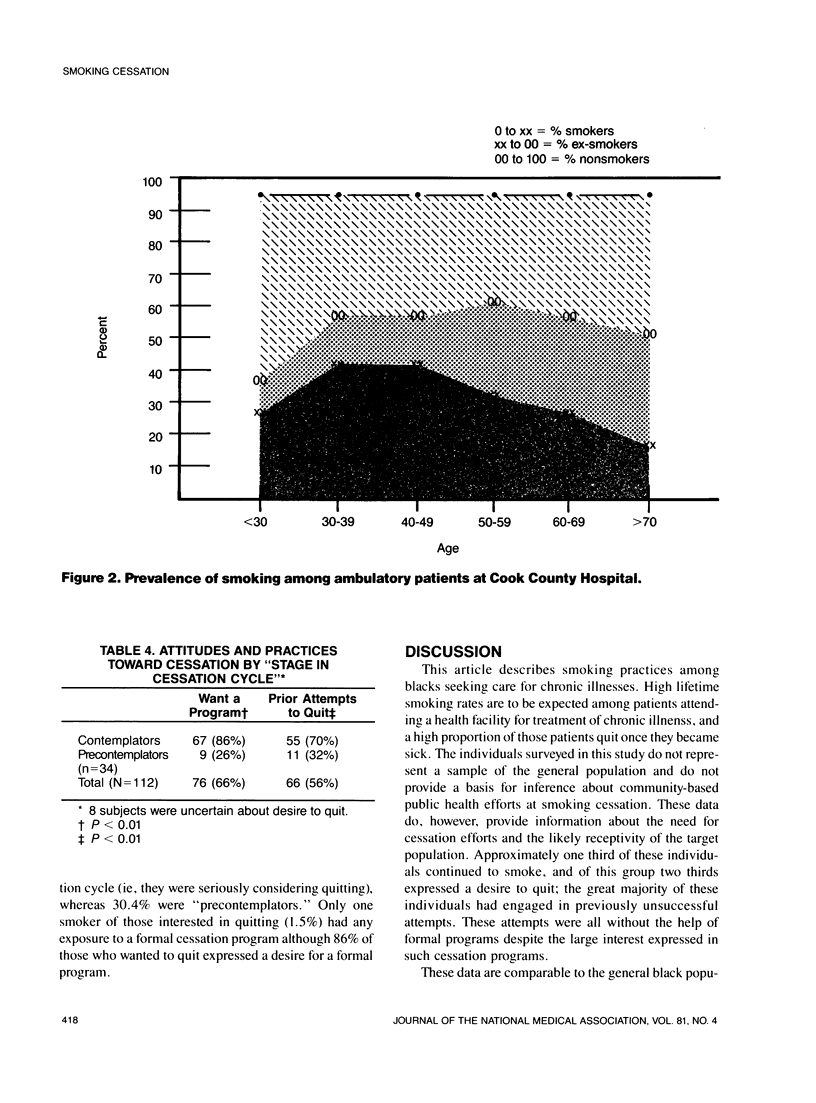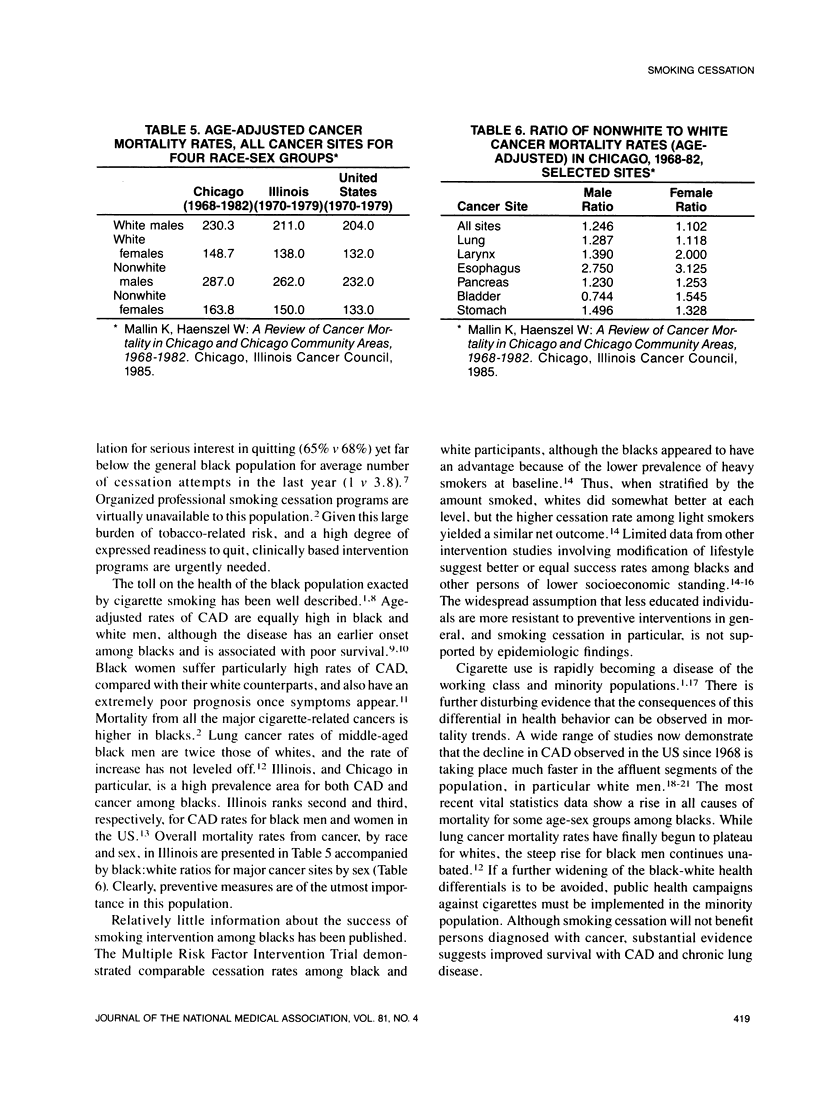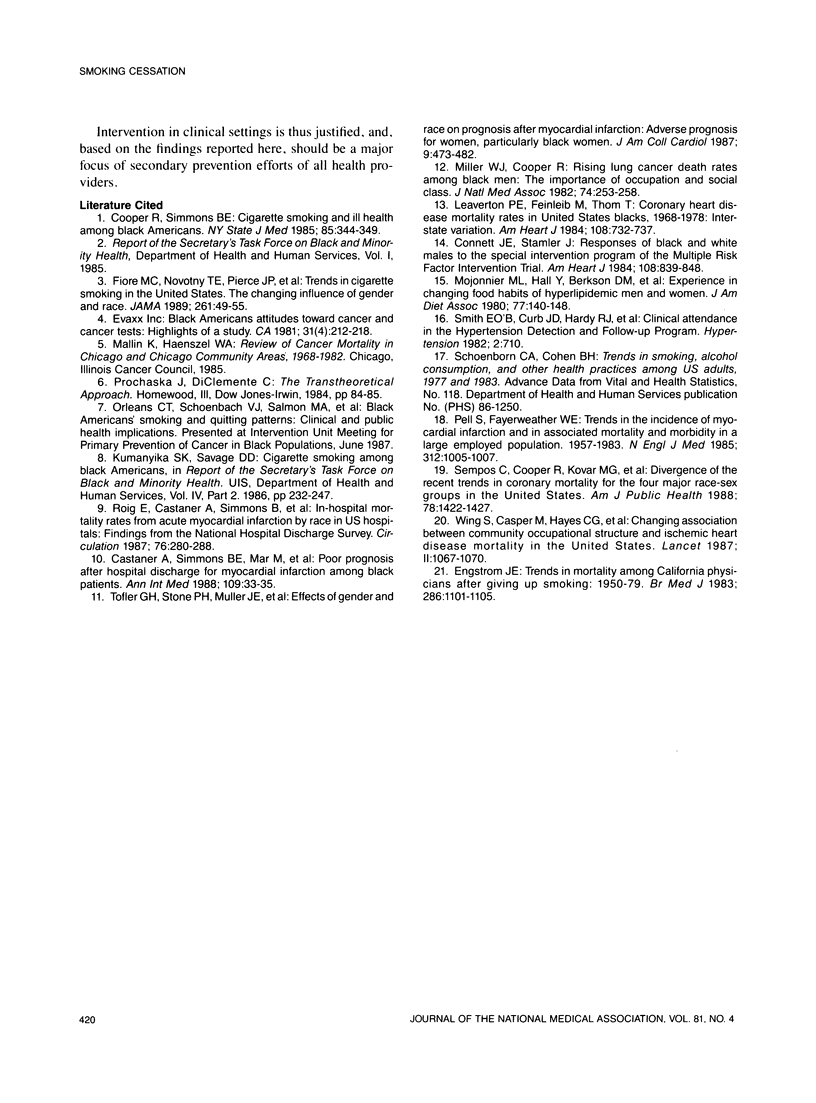Abstract
A sample of 1,388 black patients attending the medical clinic of a general public hospital were interviewed regarding smoking habits and attitudes toward quitting. Current smokers constituted 30% of respondents of both sexes, and approximately half of the sample were ex-smokers. Rates of current smoking were lower, and cessation rates higher, among older individuals and men. Two thirds of current smokers expressed a desire to quit, and of those an equal proportion wanted to participate in a formal cessation program. A majority of smokers reported attempting to quit on their own, and most had made more than one attempt. Given the large burden from cigarette-related disease in the black population, and the current absence of effective primary prevention efforts, smoking intervention in the clinical setting will remain an important obligation of health providers caring for black patients. This article demonstrates moderately high smoking prevalence rates of black individuals already under care for chronic illness, and a concomitant high level of desire to quit. The absence of effective programs appears to be the obstacle preventing significant progress in this important area of health promotion.
Full text
PDF





Selected References
These references are in PubMed. This may not be the complete list of references from this article.
- Castaner A., Simmons B. E., Mar M., Cooper R. Myocardial infarction among black patients: poor prognosis after hospital discharge. Ann Intern Med. 1988 Jul 1;109(1):33–35. doi: 10.7326/0003-4819-109-1-33. [DOI] [PubMed] [Google Scholar]
- Connett J. E., Stamler J. Responses of black and white males to the special intervention program of the Multiple Risk Factor Intervention Trial. Am Heart J. 1984 Sep;108(3 Pt 2):839–848. doi: 10.1016/0002-8703(84)90680-x. [DOI] [PubMed] [Google Scholar]
- Cooper R., Simmons B. E. Cigarette smoking and ill health among black Americans. N Y State J Med. 1985 Jul;85(7):344–349. [PubMed] [Google Scholar]
- Enstrom J. E. Trends in mortality among California physicians after giving up smoking: 1950-79. Br Med J (Clin Res Ed) 1983 Apr 2;286(6371):1101–1105. doi: 10.1136/bmj.286.6371.1101. [DOI] [PMC free article] [PubMed] [Google Scholar]
- Fiore M. C., Novotny T. E., Pierce J. P., Hatziandreu E. J., Patel K. M., Davis R. M. Trends in cigarette smoking in the United States. The changing influence of gender and race. JAMA. 1989 Jan 6;261(1):49–55. [PubMed] [Google Scholar]
- Leaverton P. E., Feinleib M., Thom T. Coronary heart disease mortality rates in United States blacks, 1968-1978: interstate variation. Am Heart J. 1984 Sep;108(3 Pt 2):732–737. doi: 10.1016/0002-8703(84)90666-5. [DOI] [PubMed] [Google Scholar]
- Miller W. J., Jr, Cooper R. Rising lung cancer death rates among black men: the importance of occupation and social class. J Natl Med Assoc. 1982 Mar;74(3):253–258. [PMC free article] [PubMed] [Google Scholar]
- Mojonnier M. L., Hall Y., Berkson D. M., Robinson E., Wethers B., Pannbacker B., Moss D., Pardo E., Stamler J., Shekelle R. B. Experience in changing food habits of hyperlipidemic men and women. J Am Diet Assoc. 1980 Aug;77(2):140–148. [PubMed] [Google Scholar]
- Pell S., Fayerweather W. E. Trends in the incidence of myocardial infarction and in associated mortality and morbidity in a large employed population, 1957-1983. N Engl J Med. 1985 Apr 18;312(16):1005–1011. doi: 10.1056/NEJM198504183121601. [DOI] [PubMed] [Google Scholar]
- Roig E., Castaner A., Simmons B., Patel R., Ford E., Cooper R. In-hospital mortality rates from acute myocardial infarction by race in U.S. hospitals: findings from the National Hospital Discharge Survey. Circulation. 1987 Aug;76(2):280–288. doi: 10.1161/01.cir.76.2.280. [DOI] [PubMed] [Google Scholar]
- Sempos C., Cooper R., Kovar M. G., McMillen M. Divergence of the recent trends in coronary mortality for the four major race-sex groups in the United States. Am J Public Health. 1988 Nov;78(11):1422–1427. doi: 10.2105/ajph.78.11.1422. [DOI] [PMC free article] [PubMed] [Google Scholar]
- Smith E. O., Curb J. D., Hardy R. J., Hawkins C. M., Tyroler H. A. Clinic attendance in the hypertension detection and follow-up program. Hypertension. 1982 Sep-Oct;4(5):710–715. doi: 10.1161/01.hyp.4.5.710. [DOI] [PubMed] [Google Scholar]
- Tofler G. H., Stone P. H., Muller J. E., Willich S. N., Davis V. G., Poole W. K., Strauss H. W., Willerson J. T., Jaffe A. S., Robertson T. Effects of gender and race on prognosis after myocardial infarction: adverse prognosis for women, particularly black women. J Am Coll Cardiol. 1987 Mar;9(3):473–482. doi: 10.1016/s0735-1097(87)80038-4. [DOI] [PubMed] [Google Scholar]
- Wing S., Dargent-Molina P., Casper M., Riggan W., Hayes C. G., Tyroler H. A. Changing association between community occupational structure and ischaemic heart disease mortality in the United States. Lancet. 1987 Nov 7;2(8567):1067–1070. doi: 10.1016/s0140-6736(87)91490-5. [DOI] [PubMed] [Google Scholar]


